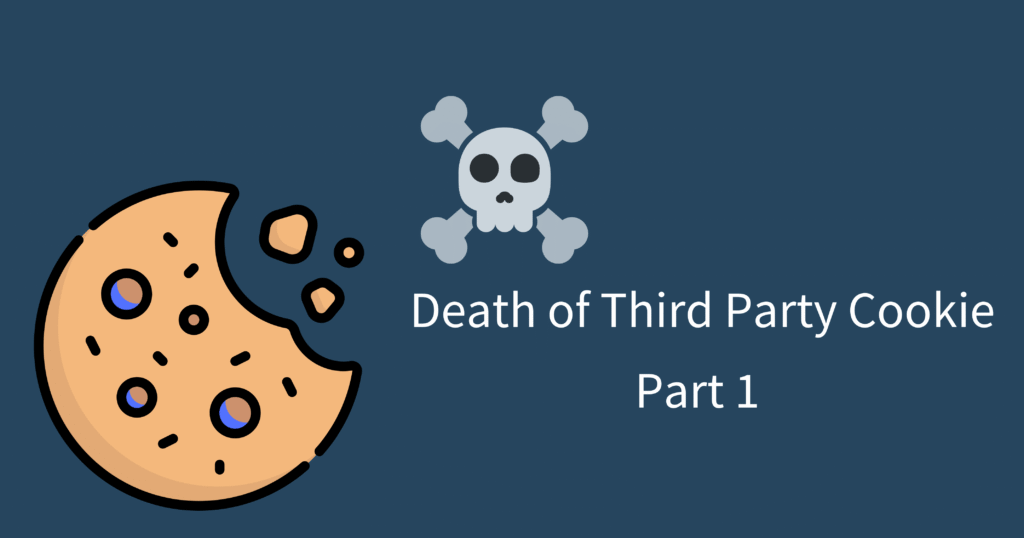
Death of Third Party Cookie Part 1
By now, all the marketers are aware of Google's plan to phase out third-party cookies in Chrome. It's not too far. By the end of 2023, the third-party cookie will…

By now, all the marketers are aware of Google’s plan to phase out third-party cookies in Chrome. It’s not too far. By the end of 2023, the third-party cookie will be resting in peace. What does this mean for you? How would it change your customer targeting and marketing performance analysis? What steps need to be taken to plan ahead and minimize the disruptions? Read on to get answers to these questions.
Impact on Customer Targeting
With the third-party cookie, a customer who visited your website and left with or without giving contact details (unknown customer) could be followed across other websites without knowing his/her contact details. You had a way of reminding, emphasizing, and enticing the customer with your best offer. With the third-party cookie gone, retargeting the customer across other domains would not be possible, and businesses may see a sizable impact on their conversions.
The way out – First Party Customer Repository
First thing First – Google isn’t banning all cookies. So far, it’s only planning to phase out third-party cookies on its browsers. However, first-party cookies that track basic data about your website’s visitors will still be available, allowing you to create your own first-party customer repository.
This was always very important.However, earlier marketers had an easy way out and were still able to reach interested customers with the help of third-party cookies.With that option going out of the picture, It has become essential to double down on building a first-party customer data repository. Not only for effective targeting but also to offer personalized customer engagement.
Building Robust Customer Profiles
Being able to collect first-party data is just one of the aspects you also need an efficient way of managing it: this is where Customer Data Platforms (CDPs) come into play.
CDPs enable customer data (First/second and Third-party) collection from multiple disparates sources such as your website, mobile app, CRM, Customer support system, Data warehouses, etc. It also provides the functionality to create a single view of customers and build enriched customer profiles to feed into various downstream systems.
Different organizations may be at different maturity levelsin building their CDP. Some of the questions below might help you evaluate where you stand:
• Are you still counting how many, or have you started focussing on who?
• Do you collect information on anonymous users?
• Does your CDP provide a unified customer profile?
• Do you have access to real-time customer behaviour?
Focussing on Who and not How many –
Companies have often used web analytics tools such as Google Analytics to get the sum and total of customer visits and aggregated customer behaviour. Every user, in that case, is just a session aggregated to analyze your marketing performance. The time has come to start looking at individual sessions as users with activities and build the user’s profile from session to session and across devices. This data will help you differentiate who is looking for a product, who is checking the pricing, who is evaluating the testimonials, and then personalize your communication accordingly.
Anonymous users
Your anonymous users (Users who visited your app/ website but didn’t leave contactinformation )are highly qualified leads. These are the users who have shown some interest in your product and services. These are your lowest-hanging fruits for improving conversion.With third-party cookie going out the window, there is no way you will be able to follow them on other websites/domains.
You might decide to leave them out of the equation or take steps to be able to collect their details and leverage that insight to entice the user to leave their contact details. A CDP can give you detailed insights into your anonymous users and their behaviour enabling you to plan actions to convert them into known entities.
Unified Customer Profiles
Customers hardly ever complete the transaction in one single go. The journey would most likely span across multiple sessions and multiple devices. What is required then is to tie different customer actions together. Having that unified view improves your ability to leverage contact details and target the customer with the right messaging
Real-time customer behaviour events
Once you know that the customer is interested in one of your products or services, timely action to convert him into a buying customer can hugely impact your conversion.There is no point in offering him a deal when he has already procured your competitor’s product. The way out – real-time customer events (‘customer Logged in’, ‘Product added to cart’, etc. ) to allow marketers to plan appropriate real-time campaigns.
Right CDP for your needs
When selecting the right CDP solution, It’s important first to understand your current ecosystem and needs. Different CDP solutions provide diverse integration ecosystems, approaches and functionality.
Click on the link below to explore some of the best CDP solutions to tackle the death of third-party cookies.
Get in touch with us if you want a hand in mapping CDP solutions for your ecosystem and your requirements
You Might Be Interested In

Unleashing the Power of Large Language Models
In today's digital age, Artificial Intelligence (AI) continues to push the boundaries of what's possible, and one area that's capturing widespread attention is Large Language Models (LLMs). These sophisticated AI…

Marketing Automation
Organizations with a sizable inflow of users on their website or mobile application grapple with the task of managing these leads for effective conversion. Users looking at your products/services may…

Metadata Management Guide
What is Metadata Management? Metadata, in simple terms, is data about data. Metadata Management refers to managing, maintaining and governing the metadata of an organization. Metadata serves many purposes, but…


